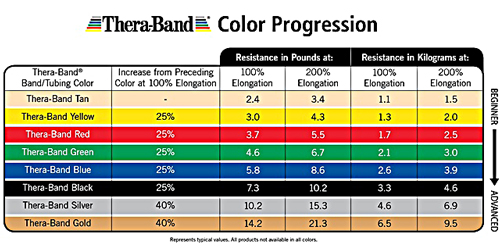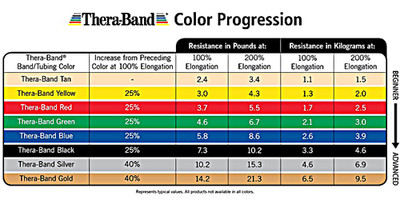 22nd Oct 2009
22nd Oct 2009
Thera-Band Colors Sequence Resistance Levels
Theraband Resistance Band Colors Explained
You’ve decided to start strength training with theraband resistance bands, but unless you’re working with a professional, you’re probably wondering what the colors mean and how you find out which theraband color you should start with. Well, you’re not alone. We break it down for you in this easy theraband resistance bands guide: Theraband Colors Explained .
Therapy bands follow a progression
- Yellow Resistance Band (SKU 101236) - 1-6 pounds of resistance (lightest)
- Red Resistance Band (SKU 101237) - 2-7 pounds of resistance (light)
- Green Resistance Band (SKU 101238) - 2-10 Pounds of resistance (light-medium)
- Blue Resistance Band (SKU 101239) - 3-14 Pounds of resistance (medium)
- Black Resistance Band (SKU 101240) - 4-18 Pounds of resistance (heavy)
- Silver/Gold-10-40 Pounds of resistance (heaviest)
Shop for Resistance Bands from ProHealthcareProducts.com
Our Most Popular 5-Piece CanDo Resistance Band SetBUY THE SET NOW FOR $19.50This set comes with five 4-foot exercise bands, including the following resistance colors:
|
How to Use Theraband Color Chart
All resistance bands are stretchy, but the varied resistance changes the effort to pull against them and stretch them out. Not only can you pick the band to use, based on your fitness level, but each type of rehab band has its specific use depending on which part of the body you want to work on.
Related Article:
What Exercises are Yellow Theraband Resistance Bands Good For?
The yellow bands are classified as light resistance. This means that they are very stretchy, and it takes little effort to pull against them and stretch them out. These therabands are great for areas like shoulders and shins, where you don't need much resistance to feel the muscle working.
What Exercises are Green Theraband Resistance Bands Good For?
The green resistance bands are considered medium resistance. These bands are less stretchy and have more tension than yellow and red bands. Green bands are used for muscle groups that need slightly more tension, such as the biceps or triceps.
What Exercises are Red Theraband Resistance Bands Good For?
Red Theraband resistance bands are considered medium to heavy resistance. They have a higher level of tension than green or yellow bands and are harder to stretch. These are the therabands to help work larger muscle groups, such as the legs, chest and back, or for individuals who have been building muscle strength.
What Exercises are Blue Theraband Resistance Bands Good For?
Blue resistance bands are medium-to-heavy resistance. These Therabands are much stiffer and don’t provide as much stretch. Since these are very strong, they can be used for legs, chest and back.
What Exercises are Black Theraband Resistance Bands Good For?
Black resistance bands have heavy resistance. These bands are very difficult to stretch and pull. Like blue bands, black bands are used for the large muscle groups, such as the legs, but they are more appropriate for use in patient populations who are at the end of their recovery or do not have significant strength deficits.
What Exercises are Silver/Gold Theraband Resistance Bands Good For?
Silver and gold Therbands have the most resistance. These bands are very difficult to stretch and pull. Appropriate for the large muscle groups of legs, back and chest, these are usually not used in rehabilitation except with patients who have regained strength or do not present with significant deficits.
How To Use Resistance Bands
So, if you’re wondering how to use Theraband resistance bands, think of them as a good alternative to weight training. Since exercise bands do not rely on gravity for resistance, you can use them to perform a larger variety of exercises, like squats and bicep curls, rather than free weights. However, the different colors and strengths of the bands don’t correspond to specific weights, rather you want to pick your band color based on the part of your body you want to work.
Why Use a Theraband Resistance Band for Exercise
Since the muscles of the body vary in size and strength, you’ll also want to vary the colors you use depending on the area of the body and the force capacity you have for that muscle group. Resistance bands can work in your full range of motion, but are less force on the joints, making them less stressful on the joints.
Using Resistance Bands for Exercise In a Nutshell
Each muscle group will require a different resistance. It's best to have at least three - light, medium and heavy to have an effective full-body workout. Experiment to see which exercise band works for you.
Benefits of Resistance Bands for Strength Training
- Prevents injury, deterioration, and disease
- Promotes weight loss
- Improves posture and balance
- Strengthens target muscle groups
Contact us today!
We can help you find the perfect therapy bands for your clients or personal use. Contact us today and we’ll answer any questions you may have about using resistance bands! Call us today at 1-801-770-3328 for more information.
The resistance bands we sell on ProHealthcareProducts.com are color coordinated using a patented color code sequence from Thera-Band. The following products use the Thera-Band Colors Sequence:
- Cando Exercise Bands
- Cando Latex Free Exercise Bands
- Thera-Band Exercise Bands
- Thera-Band Latex Free Exercise Bands

We frequently receive requests from customers for information about the details of the Thera-Band colors sequence. Thera-Band has provided a very helpful guide to using their color chart. The following is from the Thera-Band user manual for resistance bands and resistance tubing:
Elastic resistance is a unique type of resistance training compared to other traditional forms, such as isotonic or isokinetic resistances. The resistance provided by elastic bands or tubing is based on the amount that the band or tubing is stretched. This resistance can be measured in pounds of force depending on the percentage the band or tubing is stretched from its resting length; this is known as “force-elongation”. Regardless of how long the band or tubing is before it’s stretched, the force produced at its stretched length depends on the percent elongation. For example, an initial 2 foot (60 cm) length of green band that is stretched to 4 feet (120 cm) (double its resting length), is at 100% elongation.
Therefore, the resistance of the band is 5 pounds (2.3 kg) at that elongation. If the band is then further stretched to 6 feet (180 cm) (200% longation), the resistance would be about 8 pounds). There is approximately a 20-30% increase in resistance between Thera-Band colors at 100% elongation.
Thera Band Resistance Training Bands are color coded. Each color represents a different resistance level.
The charts show the resistance strengths for the Thera-Band colors sequence. The first chart shows the resistances in pounds, and the second gives the same information in units of kilograms.






